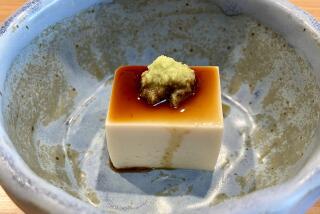Conversations From Another World
- Share via
Butoh is a strange planet for anyone who doesn’t see it regularly--or perhaps even for those who do. It’s not mime or moving meditation or dance as it’s commonly defined in the West, although it resembles all three. It is a form of dance forged in post-World-War II Japan by experimenters who rejected traditional movement vocabularies and embraced distortion and discontinuity.
It’s a way of life as well, practitioners will tell you--and this is particularly true for butoh luminary Min Tanaka and the four members of his company, Tokason, who appeared with him at the Japan America Theatre on Friday night. From brief biographies in the program, you could tell that their way of life includes working on the farm that’s their home in Japan and that Tanaka’s rhetoric when it comes to dance is one of “primitive” and “instinctual” roots.
On the other hand, from watching the U.S. premiere of “Caprice: Guests From the Dark,” you could tell that butoh is not necessarily instinctual. It’s a style of dancing that’s somewhat predictable on the surface (the chalky-faced grimacing and the careful, puppet-like meandering) and can be stunningly original at its heart.
Sometimes, it takes a good long while to attune to butoh’s rare atmosphere.
The first half of the hourlong “Caprice,” inspired by Goya’s “Los Caprichos” sketches, seemed like a long warmup, a testing of the air in another galaxy. Dancers inched into separate positions with lyrical unsteadiness, their crabbed feet hovering above the floor before meeting it solidly, their mouths freezing in rubbery spasms. Dana Iovacchini’s searingly crossed eyes and mobile face was singularly riveting, but all the dancers were related by their concave posture and bent knees. A typical phrase was to shuffle, halt, expand briefly, sink down and tilt forward until forehead met floor.
Explorations by newly mobile toddlers came to mind, or inebriates who hear a different drummer and whose joints play tricks on them. Idiosyncratic quirks prevailed, but there was little to engage the eye or mind yet, except for minor eccentricity. This left plenty of time to notice the way Goya’s stark sketches could be evoked by Keishi Suzuki’s set and Ami Tanaka’s lighting. Bodies emerged from behind several black gauze panels or basked in overhead beams of glaring white or ivory light. A long swath of fabric bisected part of the stage, seeming to change shape as shadows passed over its surface.
Dressed in a kind of stark, shabby-chic collection of well-worn trousers, overskirts and jackets (bits of lace here, a derby hat there), the dancers barely seemed aware of composer Takuya Takahashi’s soundscape, but they flinched or swayed occasionally to electronic clanks, intermittent high-pitched whines and crescendos of rain and train sounds. Crickets chirped and bells sounded in quieter moments.
At one point, Tanaka was left alone onstage and became fascinating in a rush of responses to the familiar “ay-ay-ay-ay” chorus of “Cielito Lindo.” It looked as if he were inhaling guitar rhythms and transforming them into tapping feet, jaunty jabs and odd shifts. Then it seemed he was trying to waltz without knowing the steps or to shake the repeating notes from his face with a scowl. As the piece came to an end, all five dancers (the cast included Shiho Ishiharaand Hidekazu Natsui) drifted from their individual orbits into a cluster center stage. Their stylized dipping and fractured gestures--motivated by unseen forces and whimsical impulses--started to resemble a racing stream of consciousness.
The setting for an outdoor coda to “Caprice” was provided by artist Hirokazu Kosaka, whose courtyard installation (called “The Buffer Zone”) consisted of a blue-and-white striped ground covering and a line of dried rice stalks, hanging like abstract scarecrows behind a searchlight pointed at the full moon.
To what sounded like a Japanese pop song, Tanaka capered, leaned dangerously close to the searchlight’s flame and reached toward the moon. It could have been a conversation; on the planet butoh, it’s hard to tell.
More to Read
The biggest entertainment stories
Get our big stories about Hollywood, film, television, music, arts, culture and more right in your inbox as soon as they publish.
You may occasionally receive promotional content from the Los Angeles Times.










